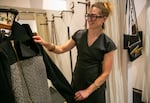Fashion
How fast fashion changed Portland’s local clothes making scene

On a July evening in downtown Portland, Sarah Eustis wore an elegant ivory dress with a periwinkle sash.
She was catching up with her friend, Erica Lurie, who created the gown and owns the boutique, Garnish Apparel. Eustis first wore the gown for her wedding. She put it on again for the store’s 20th anniversary.
“Erica used to make wedding dresses and she made my wedding dress,” Eustis says while Lurie ties the periwinkle sash into a bow. “2010 is when we got married, and it was one of the last wedding dresses she made.”
Lurie chimes in, saying she loves that Eustis wears it every five years when Garnish celebrates an anniversary.
While Lurie did move on from wedding gowns to everyday attire, she’s still crafting clothes meant to last for decades. She represents a dedicated group of Portland designers and clothing makers that — so far — have adapted as America’s shopping habits for clothes have radically changed.
Erica Lurie, left, ties a bow on the back of Sarah Eustis’s wedding dress. Lurie made this dress for Eustis’s 2010 wedding, and Eustis has since re-worn it to several events, including the 20th anniversary party for Lurie’s boutique Garnish, pictured here on July 27, 2024.
Anna Lueck / OPB
That shift has been fueled by the rapid rise of online shopping and changing global trade policies that have led large retailers to choose quantity of options over quality. Together these trends are often called “fast fashion.”
But when Lurie opened Garnish in 2004, smartphones had yet to grace the pockets of most consumers. Instead, Portland was growing a unique fashion and cloth-making community.
“There was just a real energy,” Lurie recalls. “People were doing fashion shows, and there was something called the Fashion Incubator, it was a place where people could go and take classes on the industry.”
At that time, Marjorie Skinner was reporting on fashion for the alt-weekly Portland Mercury, where she worked as the managing editor.
“I think that there was always an audience that was really invested in buying local,” Skinner said. “And you start to see that really become a hallmark of what Portland became nationally known for with its maker culture.”

Erica Lurie shows off a sample of a jacket she designed at the Garnish boutique in Old Town Portland, Ore., July 27, 2023. Lurie founded Garnish, a womenswear boutique filled with her designs, in 2004.
Anna Lueck / OPB
Skinner said Portland designers and clothes makers gained a reputation for taking damaged clothes and remaking them into something useful and unique. Many designers helped create this culture, she said, as did a network of locally owned stores.
The scene had momentum even as smart phones and online shopping were shifting from obscure to the norm. There was anticipation at the time the internet would boost local clothing designers and makers.
“But it didn’t end up being this exponential growth that I think some of us had sort of envisioned and hoped would happen,” Skinner said. “Because online sales just became more and more accessible, more and more sophisticated.”
It was mostly larger retailers with the financial means to take advantage of the growth of online shopping. Skinner says that changed the way most of us thought about clothes. Shoppers increasingly felt clothes should be cheap and plentiful, and might not think about larger social and environmental costs.
Experts from the United Nations say since the middle of last century, clothes making has become a globalized industry. The shift has had negative environmental effects. The U.N. estimates the fashion industry contributes up to 10% of global greenhouse gas emissions.
“This is something that more and more awareness is going to build around in the way that it did around big tobacco, big oil,” Skinner predicts.

Libby Hartung, owner of Zelda’s Shoe Bar, shops for clothes at Garnish during the shop’s twentieth anniversary party on July 27, 2024. Garnish, a womenswear boutique in Old Town Portland, has sold founder Erica Lurie’s designs since 2004.
Anna Lueck / OPB
The cost of making it work
Until 2019, Mink Boutique was among the Portland clothing businesses making it work through the rise of the internet and fast fashion.
Former owner Carla Mink says when she opened the shop in 2007 she only sold clothing from other designers. But within a few years she realized customers were finding and trying on new clothes at her store, but wouldn’t buy them. Instead, they’d go home and buy directly from the designer online.
“I realize that if we didn’t have our own brand that people could only get at our store,” Mink said, “that it just was eventually not going be sustainable anymore.”
Mink consulted with a group of boutique owners she was a part of. Lurie at Garnish and others encouraged her to design and make her own clothes — which Mink said ended up being one of the best parts of her job.
Eventually, though, the amount of time and energy she put into the store and designing her own line wasn’t working.
“To be able to run the shop, run the e-commerce platform, and make all my own clothes — my average week was definitely 50 to 70 hours,” Mink said. “That was just my average week. That’s how much I had to work to get all those jobs done, and then with two little kids and not sleeping, it just felt untenable.”
Mink’s shop was profitable and supported a handful of employees directly, and indirectly supported more than a dozen seamstresses. Still, Mink decided to close up shop and became a realtor.

Belts. jewelry, and clutches on a table at Garnish, a womenswear boutique featuring founder Erica’s Lurie’s designs, during the store’s twentieth anniversary party on July 27, 2024.
Anna Lueck / OPB
Trying to survive as ‘the opposite of fast fashion’
Back at Garnish, Lurie says the group of boutique owners she and Mink were a part of doesn’t exist anymore.
“So many people had closed that eventually the group just dissolved,” Lurie said.
It keeps getting harder to compete with large retailers that manufacture in countries with lower labor costs, she said. Meanwhile, Lurie’s business model includes employing a full-time local seamstress.
She also employs a designer and marketer. But it doesn’t compare to budgets big corporations have to keep their online platforms up to date — which is what consumers have come to expect.
“Now you can just jump on your phone, go on Instagram, and in two seconds you have all of the possibilities of the entire world at your fingertips,” she said.
And yet, she points to Portland designers like Adam Arnold and the company Duchess Clothier that crafts custom suits and formal wear that are making it work in today’s fashion industry.
As for her shop, Lurie calls it the opposite of fast fashion. Her garments are crafted by people in Portland and meant to last decades, and Lurie and her team work with customers individually to find the right wardrobe pieces.
“We will spend two or three hours with you just really trying to develop your style for you and your lifestyle, your body shape, your coloring, all of those things,” Lurie said. Those are the kinds of experiences that you gain when you are shopping locally.”









